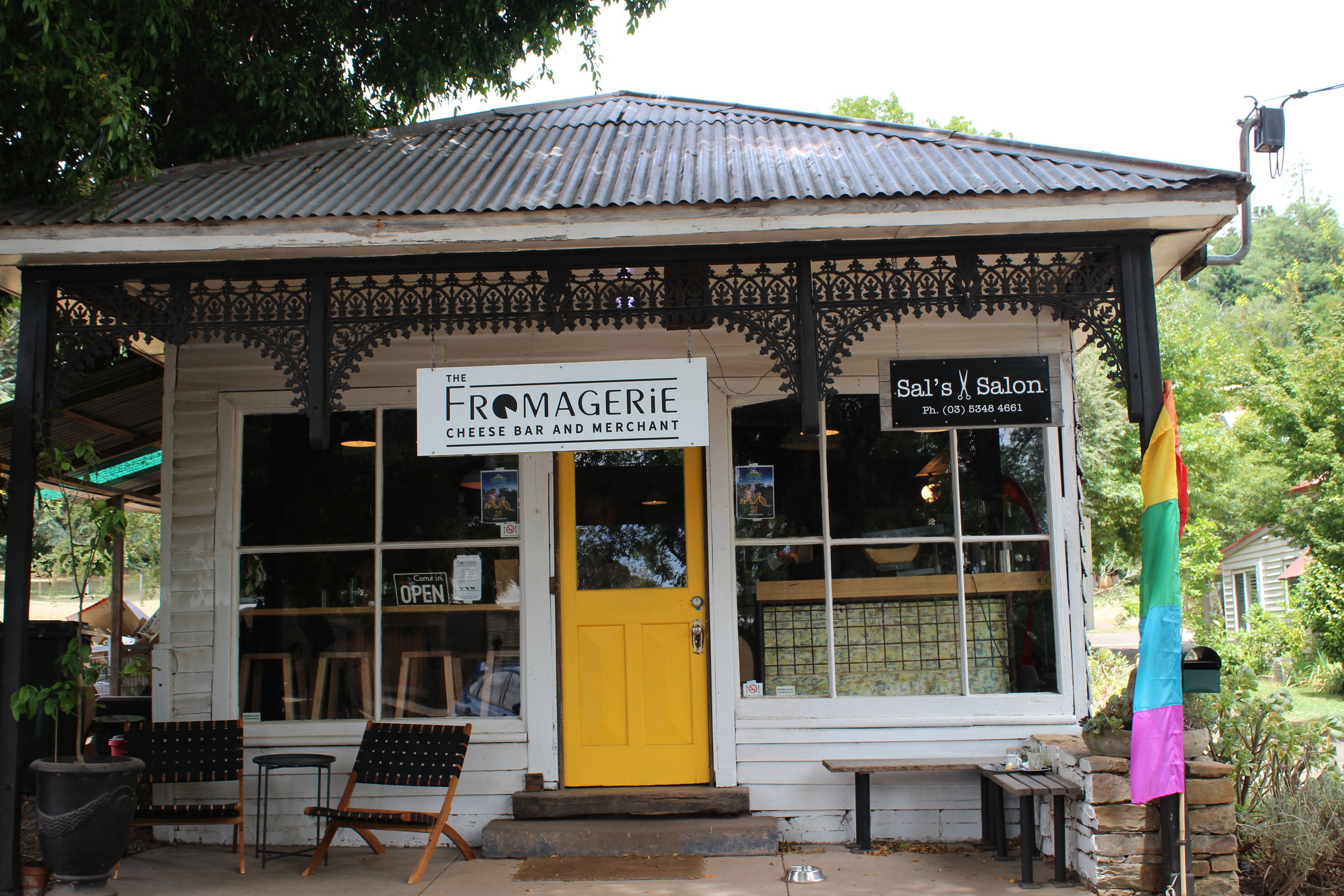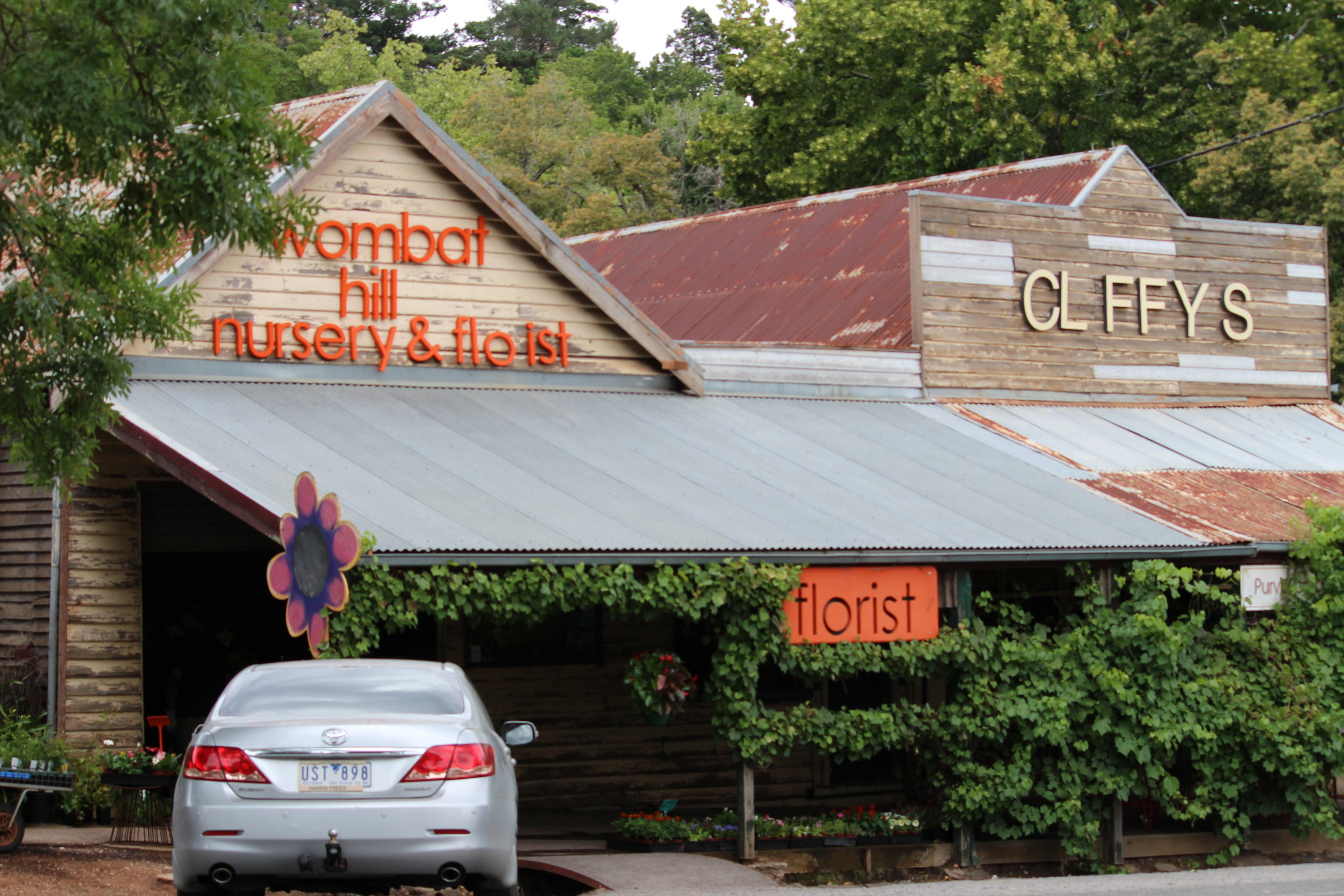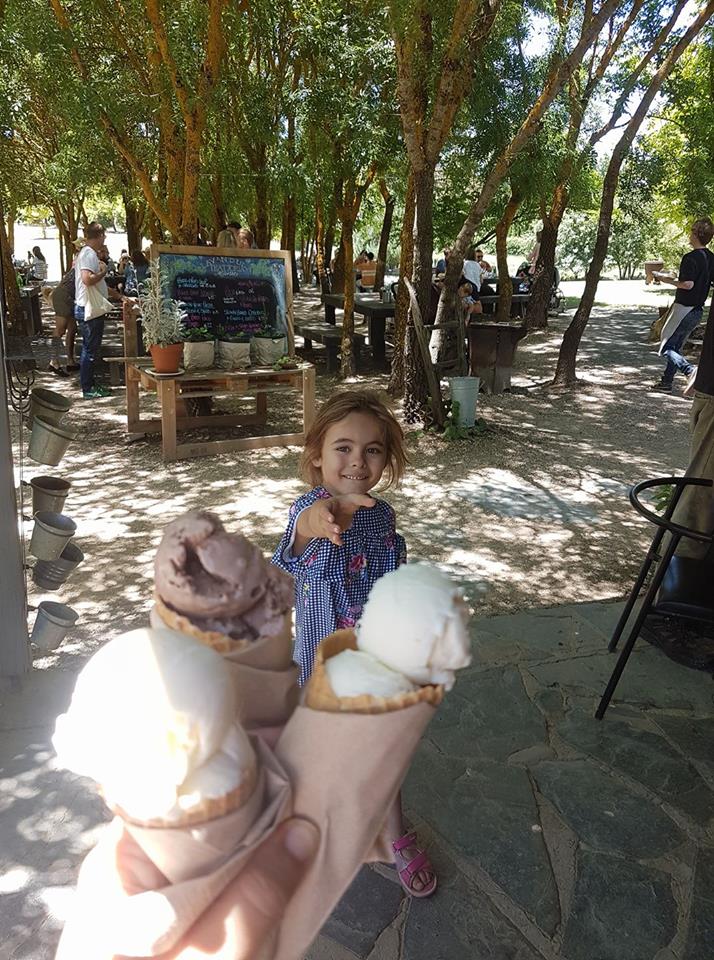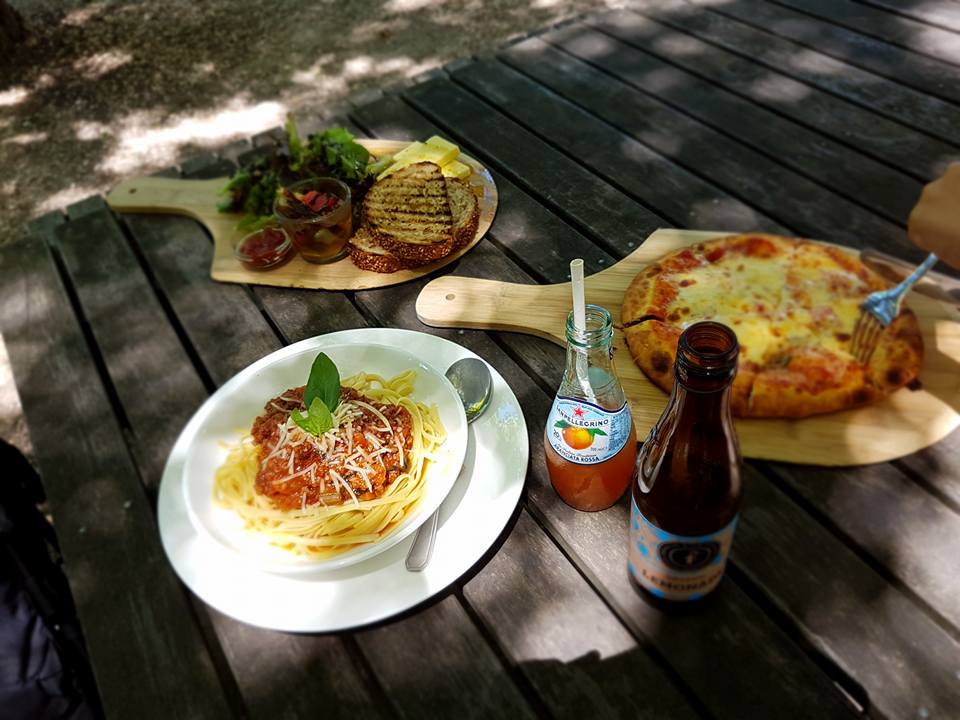Reviving the Bull Boar
Exploring Daylesford's local food culture and it's attempt to save a secret sausage from self-combustion.
Vincent Street, Daylesford
There are many good reasons to come to the county town of Daylesford. The Hepburn Shire of which Daylesford belongs has long been regarded as Australia’s leading spa, health and wellness region, boasting more than 70 of Victoria’s 110 documented mineral springs as well as an enviable reputation for its diverse, high-quality regional produce, excellent wines, bustling farmers markets, art galleries and internationally acclaimed restaurants. Visitors come from all over the world to taste the ethical, locavore, organic and ‘slow’ way of life for which the region is renowned and attracts many tree-changers, hipsters, celebrities and a strong LGBTI population.
Images: The Fromagerie Cheese and Wine Merchants, 22 Raglan Street, Daylesford (top left), Wombat Hill Nursery and Florest, 28 Raglan Street, Daylesford (top right), Organic grains for sale at the Daylesford Sunday Market, Daylesford Railway Station, 18 Raglan Street, Daylesford (bottom).
As you drive along the peaceful country roads into Daylesford, you will frequently pass a sign, stall or roadside honesty box displaying juicy oranges, freshly dug potatoes, a variety of home-made jams and preserves and of course local honey – an indication of the extent to which an agricultural way of life has permeated into the community.
Russel Dooley sells organic oranges using an honesty box.
Located in the foothills of the Great Dividing Rage and under ninety minutes’ drive from Melbourne, the Daylesford town center will greet you with beautiful historic buildings, cosy and quirky café’s and a visitor information center to assist newcomers with finding the region’s ‘must see attractions’.
While there is no doubt that this ‘slow’ way of life is aggressively promoted in the marketing efforts of local business and various tourism bodies, there is a genuine culture of respect for the terroir, pride in a self-sufficient local economy and a diverse and accepting sense of community.
There is also a strong feeling of respect for the original indigenous owners of the land – the Kurang, Wurundjeri and the Jarra clans who were taken to the Loddon Protectorate at Franklinford prior to 1849 and who were the supreme knowledge holders of respectful management of this lush and dense terrain.
How Daylesford succeeded in retaining a culture of traditional food production, multiculturalism, tolerance and acceptance of alternative living in a post-modern age of convenience and fast food, intensive farming practices and mass consumerism is a story best told through the history of the people commonly referred to as the Swiss Italians who emigrated to the area during the Australian gold rush and their beloved Bull Boar sausage.
To learn more, I met with Daylesford local and Slow Food Convivium Leader, Gary Thomas. Gary is also the executive chef of Blade to Spade catering and a descendant of the original Swiss Italian settlers.
“My Swiss Italian family migrated to the area in 1863. They came from a little village called Ticino in the southern and Italian speaking side of the Swiss Alps. Two brothers came [to Daylesford] because their community was starving to death” said Gary. He explained that the town council and the Catholic Church provided funding for the young men of their village to be sent to the goldfields of the world where some found work and repatriated money. Some eventually returned home. Some chose to stay.
Gary Thomas holding a copy of his families Bull Boar recipe.
Like Gary’s ancestors, the people of northern Italy and the Italian speaking cantons of Switzerland immigrated to Australia throughout the 1850’s in the hope of finding a solution to the extreme poverty of their mountain villages. According to research conducted into fifteen of the original Swiss Italian settlers and their families by historian Bridget Carlson (1997), the Jim Crow goldfields (later renamed to Daylesford) represented one of their last hopes for a more prosperous life. It was here in the auriferous rich central highlands of the Colony of Victoria, that the Italian speakers overcame their struggles to preserve language, cultural traditions and lifestyles and adapted to the needs and demands of a new environment and society.
Having brought with them comprehensive survival skills from their homeland, their small and often inhospitable blocks of land were farmed to provide a self-sufficient lifestyle. One of the most important expressions of the Swiss Italian’s cultural heritage in Daylesford was the management of their domestic life and property which enabled them to not only overcome poverty and deprivation but also to retain a rich social life.
Some years after first arriving and settling into their new environment, the Swiss Italians planted vegetable crops and fruit trees around their homes to supply most of their nutritional needs. Using regenerative farming methods, they were able to improve the fertility of the soil – a practical alternative to the intensive farming methods of the Anglo Australians. Many planted extensive vineyards, translating another important tradition. With a cow for milk, pigs for meat and some hens for fresh eggs, the Swiss Italians presented a picture to the Anglo Australians of well-run, efficient farms operated on a system of kinship and family ties - a way of life which likely helped to shape the attitudes, values and food culture of modern-day Daylesford.
Like many cultures around the world, traditions and cultural stories were mostly passed down verbally. When the stories failed to make useful statements to younger generations, they then failed to be retold. This combined with the inter-marrying with people from other nations, cultural adaptation was inevitable and resulted in much of the history being lost.
This was the case for Gary who explained that his Italian heritage was not at all present in his known history when growing up. No Italian was spoken and the only remanent to his Swiss Italian ancestry is his memories of his family making of Bull Boars’.
One way to preserve cultural tradition is in the making of traditional foods and one of the most delicious expressions of that heritage is the making of Bull Boar sausages. To the Swiss Italians, it was just referred to as salsicce or ’sausage’, but it is believed that the Swiss Italian settlers named it Bull Boar because it contained equal portions of beef and pork. The sausage has a very distinctive taste, heavily laden with sweet spices such as cinnamon, nutmeg, and allspice with the addition of garlic steeped red wine. Every family in the district had their own recipe which is a closely guarded secret and is one of the last links with their Italian speaking ancestry.
Gary’s tells me that one of his very earliest and most vivid memories is getting up before dawn with his father and making Bull Boars at his uncle’s family home. He recalls a cow and pig being prepared for butchery and how scraping the hide caused his hands to receive cuts and then sting when mixing the minced meat with the marinade and spices.
How the Bull Boar recipe came about is an issue of debate amongst Daylesford locals. The prevailing opinion is that the Swiss Italians brought Bull Boars with them however Gary disagrees.
On a journey to discover more about the history of the Bull Boar, Gary packed a sample of sausages with him from Daylesford to Rome, then to Terre Madre - an annual Slow Food Movement conference in Torrino, Lake Como then into Valle Maggia and finally into Binasco where he shared them with some locals. The locals were surprised at the taste of the Bull Boars and referred to them as “very rich” sausages which Gary interpreted as meaning wealthy or expensive. “These are the sausages of wealthy people [because of the spice]… when you think back to 1860 where they haven’t got a penny and you imagine that they have somehow filled these sausages with spices that they didn’t even grow? They would have been spices they needed to trade and import so it doesn’t make any sense. Even now, when I go there and they add spice, it’s just a pinch. It’s just not in the culture to do that [add a lot of spice]”.
Dried Bull Boar sausage made by Gary Thomas
Gary speculates the Swiss Italians brought with them their knowledge of sausage making and the equipment; the traditional style of sausage being Luganega or in the thin form Luganegnetta and they were made and dried as a salami ‘salumetto’. From this, the Bull Boars developed very quickly in their current spicy form as an expression of the wealth of the goldfield.
“Spices would have only been available from traders, who’s there trading, Chinese merchants and the English. I’ve looked at 40 or 50 family recipes where the spice mixes are different. What you never ever see is fennel, a classic Italian meat spice and chilli, you never ever see those”.
In agreement with Gary is local butcher Danny Wayne. Danny makes and sells Bull Boars in his shop –the ‘Albert Street Butchery’. Danny uses a recipe that was handed down to him by his brother and previous owner of the shop who also inherited it from a former owner. Danny uses a 50/50 mix of locally sourced beef and pork, garlic infused red wine, salt, cinnamon, nutmeg, white pepper and small amounts of mace, cloves, and pimento. Danny explains that not many people make Bull Boars now, although a few families still do. “In the old days, one family would provide the cow and another would provide the pig”. A lot of families now buy the premade fresh sausages from the shop and dry them during the winter for salami. He also explained that it is a very local custom and not many visitors to the region come in to purchase them.
Butcher Danny Wayne
As for the taste, Danny says that they are unique not just because of the heavy use of spicing – the meat takes on the flavour of the local pasture that gives them a special flavour. “What I normally tell people who have never tried them is that you’ll either love them or hate them. Most people love them”. Nowadays, most people eat them as a fresh sausage and he adjusts the salt content accordingly. Danny recommends serving them grilled or baked with caramelised onions and mashed potatoes.
Whatever the truth is about the Bull Boar’s origins, the sausage serves as a reminder of an earlier time in history where the preparation and consumption of food were seen as an opportunity for strengthening kin and village ties through cooperative labour. A time where Bull Boars were made with help of other townsmen and women; and cooperation meant sharing tools and equipment, labour and new ideas – all of which reinforced the bonds of family and village. A period where tables were laden with peasant foods: freshly cooked sausages, home-made cheeses, local wine and other multicultural dishes donated by neighbours and new friends; and where people enjoyed the company of new people and of relishing in life’s simple pleasures.
As a strong local food advocate, Gary is concerned at the prospect that this local snag could soon be facing self-combustion due to younger generations of Swiss Italians leaving for the city in search for professional work and higher incomes and not having the time or resources to preserve this important aspect of their culture. Furthermore, he is worried by commercial business’ attempting to mimic authentic Bull Boars with disastrous results due to shortcuts in the production process. “One mistake is that, like most sausages, they throw in all the animal scraps. Proper Bull Boars don’t have beef fat. They have lots of pork fat, but no beef fat. It affects the flavour. Also, with proper Bull Boars the garlic is infused into red wine and then the garlic is discarded. It gives a much more elegant taste. Some commercial sausage makers throw in a heap of garlic and raw wine which produces an inferior result”, Gary explained.
To help preserve the continuation of Bull Boar making, this local specialty has been registered on the Slow Food movements ‘Ark of Taste’- an international catalogue of cultural dishes, ingredients, and production methods that face extinction within a few generations. Slow Food works with the community to point out the existence of these products and invite people to take action to protect them, however until the Bull Boar is protected with an official destination of origin status – of which there is currently no legislation in Australia, the recipe’s integrity and ultimate survival cannot be guaranteed.
A collection of Bull Boar family recipes.
Gary says “the food culture and food industry we have developed in our area is not to do with hanging our hat on an ingredient but rather an attitude in a whole [food] system. It’s genuine” and “the future [of the Bull Boar] is in sharing the story, in that we gather people back from the clan who are generations down and begin the process of renewal. The best protection [against vandalism and total loss of authentic recipes] is familiarity, the very deliberate policy not to be secretive about family recipes anymore”.
While the fate of original and unadulterated Bull Boars recipes seems bland, not all remnants of this early time in Daylesford’s history have been lost. Decades after the deaths of the last remaining Swiss Italian settlers, there remains in Daylesford a tangible evidence of their presence and influence. Places and streets are named in honour of those who helped to make the region what it is today such as Italian Hill, Morganti’s Road, Borsa Avenue, the Swiss Mountain Hotel. Many of Daylesford’s restaurants, through their names, décor and menu’s express the region’s Italian heritage and Bull Boar sausages can still be found in local eateries and at two or three local butcher shops. Ten minutes north of Daylesford at Lavendula Farm in Hepburn Springs, you will find a historic 1850’s homestead with European style gardens planted around the original stone buildings as well as a café serving scrumptious lunches and sweets made entirely from locally sourced ingredients.
Images: Lavender and Chocolate Ice-cream cones (top left), Lunch at Lavendula Farm Cafe (top right), Wood fired pizza oven at Lavendula farm (bottom).
There is also the yearly Swiss Italian Festa held by the people of Daylesford and Hepburn Springs every October over five continuous days to celebrate and show off their pride in the strong links to the Swiss Italian settlers of the district in the 1850’s.
In line with the regions long-standing culture of inclusion and acceptance, Daylesford will be holding its 21st Chillout Festival, regional Victoria’s biggest and longest-running country queer pride event from 8th – 12th March.
You may also like to have a go at making your own Bull Boars and can find the Gervasoni family recipe here.
CONNECT
To experience the history of Daylesford through the tasting and making of Bull Boars pop in and see Danny at:
Albert Street Butchery
22 Albert Street
Daylesford
VIC 3460
Ph: (03) 5348 2679
Gary Thomas also holds regular Bull Boar making workshops. If you are a Swiss Italian descendant looking to get back in touch with your cultural roots or interested in this special sausage making technique contact Gary via his website http://www.spadetoblade.com/contact-us/











